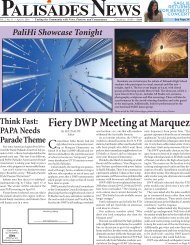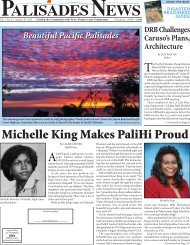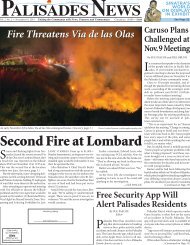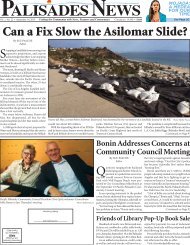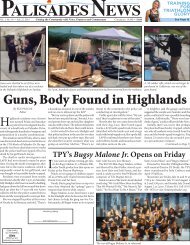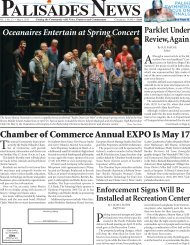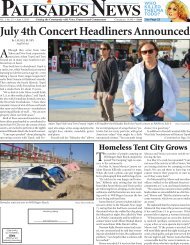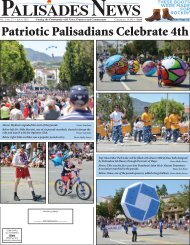Palisades-News-March-18-2015
Palisades-News-March-18-2015
Palisades-News-March-18-2015
You also want an ePaper? Increase the reach of your titles
YUMPU automatically turns print PDFs into web optimized ePapers that Google loves.
<strong>Palisades</strong> <strong>News</strong><br />
Page 20 <strong>March</strong> <strong>18</strong>, <strong>2015</strong><br />
J.W.M.<br />
Turner:<br />
Master<br />
of Sea,<br />
Mist and<br />
Light<br />
By LIBBY MOTIKA<br />
<strong>Palisades</strong> <strong>News</strong> Contributor<br />
If the renowned <strong>18</strong>th-century British<br />
artist J.W.M. Turner could have slipped<br />
into the eye of a hurricane, he most certainly<br />
would have rendered the power and<br />
intensity of the storm looking from the inside<br />
out, with an emotional intensity that<br />
seemed impossible with paint on canvas.<br />
But this was the man who claimed that<br />
he was tied to the mast of a ship on the<br />
night of a storm and witnessed it for four<br />
hours. When looking at the finished painting,<br />
“Snow Storm: Steamboat off a Harbour’s<br />
Mouth,” the viewer is caught up in<br />
that very vortex.<br />
Turner was captivated by natural phenomena—sunrises,<br />
fog and the mutable skies—<br />
J.M.W. Turner self-portrait<br />
“The Burning of the Houses of Lords and Commons, October 16, <strong>18</strong>34.”<br />
and he was obsessed with natural catastrophes,<br />
raging storms and conflagrations.<br />
Turner was captivated by natural phenomena—sunrises,<br />
fog and the mutable<br />
skies—and he was obsessed with natural catastrophes,<br />
raging storms and conflagrations.<br />
“When the Tower of London was burning<br />
down in <strong>18</strong>21, Turner applied to the<br />
Duke of Wellington to go into the Tower<br />
and make studies, but he was denied. So he<br />
made the studies from across the water,<br />
which are so incredibly fresh to our eye,”<br />
says Julian Brooks, co-curator of the exhibition<br />
“J.M.W. Turner: Painting Set Free”<br />
at the Getty Museum through May 24.<br />
The 60 watercolors and oil paintings on<br />
view represent the last 15 years of Turner’s<br />
life. Remarkably, these are the most expressive,<br />
dynamic and innovative of his life’s<br />
work, says Timothy Potts, director of the<br />
J. Paul Getty Museum.<br />
“This is an exhibition with a thesis,” Potts<br />
continues. “It wants to look at Turner’s late<br />
work and understand it going back to the<br />
end of the <strong>18</strong>th century and early 19th century<br />
when he is consciously drawing on the<br />
work of other great landscape artists. Then<br />
you have this flourish that is so totally different.<br />
Instead of defining and representing<br />
reality in a traditional way, the artist’s late<br />
work is much more expressive. It flows between<br />
solid and liquid, air and wind and<br />
sea—all these elements of nature in a very<br />
expressive and atmospheric way. That’s<br />
what appeals to modern audiences.” It has<br />
Courtesy of the Philadelphia Museum of Art: The John Howard McFadden Collection, 1928<br />
been seen as, in a sense, proto-modern.<br />
Turner was born in London in 1775 and<br />
lived as the Industrial Revolution was transforming<br />
England from hand production<br />
methods to machines. He showed an early<br />
talent for drawing and watercolor and was<br />
admitted to the Royal Academy of Art in<br />
1789 at age 14. During these early years, he<br />
developed the custom of traveling throughout<br />
Britain, producing a wide range of<br />
sketches for working up into studies and<br />
watercolors.<br />
Throughout his life, Turner continued to<br />
travel every summer on his own, often on<br />
foot, having no retinue carrying his bags. He<br />
had his boots resoled and re-heeled countless<br />
times, but he was just driven to carry<br />
on. This was where his subject matter was.<br />
He expanded his itinerary to the Continent,<br />
after the end of the Napoleonic wars in<br />
<strong>18</strong>15 when Continental travel was possible.<br />
Venice was one of his favorite places<br />
and it was easy to see why. It was all about<br />
(Continued on Page 21)<br />
“Venice at Sunrise from the Hotel Europa, with Campanile of San Marco,” about <strong>18</strong>40.<br />
Photo © Tate, London 2014




